List of Los Angeles Historic-Cultural Monuments in Downtown Los Angeles
Los Angeles Historic-Cultural Monuments (LAHCMs) in Downtown Los Angeles, Los Angeles, California are designated by the City's Cultural Heritage Commission.
There are more than 120 LAHCMs in the downtown area. These include the Old Plaza Historic District, Little Tokyo, Chinatown, the Broadway Theater District, the Spring Street Financial District, and the Fashion District.
Current and former Historic-Cultural Monuments
| HCM #[lower-alpha 1] | Landmark name[1] | Image | Date designated[1] | Locality[1] | Neighborhood | Description[2] | |
|---|---|---|---|---|---|---|---|
| 3 | Nuestra Senora la Reina de Los Angeles |  |
August 6, 1962 | 535 N. Main St. 34°3′25.44″N 118°14′22.46″W |
Old Plaza District | Built in 1822, also known as Plaza Church | |
| 4 | Angels Flight |  |
August 6, 1962 | Hill St. & 3rd St. 34°3′5.93″N 118°14′56.68″W |
Bunker Hill | Short funicular railway that operated 1901–1969, 1996–2001, and re-opened 2010; from Hill Street uphill to Bunker Hill; Cars: "Olivet" and "Sinai" | |
| 5 | The Salt Box | August 6, 1962 | 339 S. Bunker Hill Ave. 34°3′38.34″N 118°14′43.4″W |
Bunker Hill | Saltbox home that was moved to Heritage Square and then destroyed by fire; delisted January 1, 1969. | ||
| 6 | Bradbury Building |  |
September 21, 1962 | 304 S. Broadway 34°3′2.34″N 118°14′53.29″W |
Downtown Los Angeles | Architectural landmark known for its atrium; built in 1893 | |
| 11 | West Temple Apartments (The Rochester) | April 1, 1963 | 1012 W. Temple St. | Bunker Hill | Woodframe Mansard structure built in 1887; relocated in 1970 and dismantled in 1978; delisted February 14, 1979. | ||
| 16 | St. Joseph's Church | May 10, 1963 | 218 E. 12th St. | Downtown Los Angeles | Victorian Gothic church built in 1901; destroyed by fire in 1983; delisted September 4, 1963. | ||
| 17 | Saint Vibiana's Cathedral |  |
May 10, 1963 | 114 E. Second St. |
Downtown Los Angeles | Church dedicated in 1876 and extensively renovated in 1922 | |
| 26 | First Cemetery of Los Angeles | March 20, 1964 | 521 N. Main St. | Old Plaza District | First graveyard from 1823 to 1844 adjacent to Plaza Church | ||
| 27 | The Castle | May 8, 1964 | 325 S. Bunker Hill Ave. | Bunker Hill | Victorian house built c. 1882 and moved to Heritage Square in 1969; destroyed by fire and delisted January 1, 1969. | ||
| 37 | Fire Station No. 23 |  |
February 18, 1966 | 225 E. 5th S. | Downtown Los Angeles | Former firehouse built in 1910 with ornate interior; also served as department headquarters and chief's home; used as location in Ghostbusters movies, The Mask, Flatliners and others | |
| 43 | California Club Building |  |
November 2, 1966 | 538 S. Flower St. | Downtown Los Angeles | Beaux Arts brick building completed in 1930; designed by Robert D. Farquhar | |
| 46 | Los Angeles Central Library Building and Grounds |  |
March 1, 1967 | 630 W. 5th St. | Downtown Los Angeles | Dedicated in 1926, designed by Bertram Grosvenor Goodhue to mimic the architecture of ancient Egypt; third largest public library in the U.S. | |
| 60 | Biltmore Hotel |  |
July 2, 1969 | 515 S. Olive St. 34°2′56.77″N 118°15′13.72″W |
Pershing Square | Landmark downtown Los Angeles hotel | |
| 61 | Philharmonic Auditorium | July 2, 1969 | 427 W. Fifth St. | Downtown Los Angeles | Site of former home of Los Angeles Philharmonic; since demolished | ||
| 64 | Plaza Park | .jpg.webp) |
April 1, 1970 | Between Chavez Ave., Main St., Los Angeles St. and Plaza | Old Plaza District | Historic district at site of the city's original settlement; includes many of the city's oldest and most historic buildings. | |
| 66 | St. Paul's Cathedral[3] | May 6, 1970 | 615 S. Figueroa St. | Downtown Los Angeles | Episcopal cathedral built in 1920s; demolished in 1979. | ||
| 69 | Los Angeles Athletic Club Building |  |
September 16, 1970 | 431 W. Seventh St. | Downtown Los Angeles | Beaux Arts building designed by Parkinson & Bergstrom in 1912; received publicity on opening for its 100-foot (30 m)-long swimming pool on the sixth floor | |
| 71 | First African Methodist Episcopal Church | January 6, 1971 | 801 Towne Ave. (at 8th St.) 34°1′56.92″N 118°15′3.06″W |
Downtown Los Angeles | Gothic church built in 1903 based on a design by Sir Christopher Wren; destroyed by fire on July 4, 1972. Church was first organized in 1872. | ||
| 80 | Palm Court (Alexandria Hotel) | .jpg.webp) |
March 3, 1971 | 210 W. Fifth St. 34°2′50.41″N 118°14′58.85″W |
Spring Street Financial District | 200-foot (61 m)-long dining room with magnificent stained-glass ceiling | |
| 82 | River Station Area – Southern Pacific Railroad (The Cornfield) | June 16, 1971 | Between N. Broadway on west, N. Spring St. on east, north to LA River and Elysian Park, south to Capital Milling Co. Bldg. | Chinatown, Los Angeles | Area contains vestiges of 19th Century railroading, freight yards, warehouses, tracks, switch houses, docks and cobblestone pavement (now Los Angeles State Historic Park). | ||
| 101 | Union Station Terminal and Landscaped Grounds |  |
August 2, 1972 | 800 N. Alameda St. | Downtown Los Angeles | Passenger terminal opened May 3, 1939 ; designed by The Parkinsons | |
| 104 | Cole's P.E. Buffet-Pacific Electric Building |  |
October 17, 1989 | 118 E. Sixth St. | Downtown Los Angeles | Restaurant operating in the building housing the Pacific Electric terminal; opened in 1903; original designation in 1972 was for the restaurant, but amended in 1989 to include the building | |
| 119 | Cohn-Goldwater Building |  |
May 16, 1973 | 525 E. 12th St. 34°2′4.61″N 118°15′16.47″W |
Downtown Los Angeles | First modern, Class A, steel-reinforced-concreted factory in Los Angeles built in 1909 by garment manufacturers Morris Cohn and Lemuel Goldwater | |
| 121 | Garfield Building | 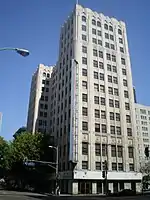 |
March 17, 1982 | 403 W. 8th St. 34°2′40.97″N 118°15′20.35″W |
Downtown Los Angeles | Opulent Art Deco style building designed by Claud Beelman, built in 1928 | |
| 125 | Fine Arts Building | April 17, 1974 | 811 W. 7th St. | Downtown Los Angeles | Romanesque structure built in 1925, designed by Walker & Eisen; also known as Global Marine House | ||
| 137 | Finney's Cafeteria |  |
January 15, 1975 | 217 W. Sixth St. | Downtown Los Angeles | Building featuring Batchelder tiles opened in 1914; originally known as "The Chocolate Shop" | |
| 138 | Coca-Cola Building |  |
February 5, 1975 | 1334 S. Central Ave. 34°1′43″N 118°14′42″W |
Downtown Los Angeles | Streamline Moderne building designed with appearance of a ship with portholes, catwalk and a bridge; built in 1939 | |
| 140 | Cast Iron Commercial Building | March 19, 1975 | 740–748 San Pedro St. | Downtown Los Angeles | Prefabricated metal building erected in 1903 | ||
| 150 | Los Angeles City Hall | _edit1.jpg.webp) |
March 24, 1976 | 200 N. Spring St. | Downtown Los Angeles | Tallest base-isolated structure in the world built in 1928. A Neoclassical base with an Art Deco tower. | |
| 161 | Wolfer Printing Company Building |  |
September 15, 1976 | 416 S. Wall St. | Downtown Los Angeles | Tudor Revival structure built in 1929, patterned after 19th-century English print shop | |
| 177 | Subway Terminal Building |  |
July 27, 1977 | 417 S. Hill St. | Downtown Los Angeles | Renaissance Revival building; built in 1925; served as the downtown terminus for the "Hollywood Subway"; currently a luxury apartment building | |
| 178 | Los Angeles Herald Examiner Building |  |
August 18, 1977 | 1111 S. Broadway | Downtown Los Angeles | Mission Revival—Spanish Colonial Revival building, designed by Julia Morgan, completed in 1915. | |
| 195 | James Oviatt Building |  |
617 S. Olive St. | Pershing Square | Art Deco structure built in 1928 designed by Joseph Feil; noted for its extensive use of Lalique glass | ||
| 196 | Variety Arts Center Building | .jpg.webp) |
940 S. Figueroa St. | Downtown Los Angeles | Five-story Italian Renaissance Revival-style theater and clubhouse built in 1924 for the Friday Morning Club; designed by Allison & Allison | ||
| 205 | Los Angeles Stock Exchange Building |  |
January 3, 1979 | 618 S. Spring St. | Spring Street Financial District | Classical Moderne architecture building was designed by Samuel E. Lunden, and opened on January 5, 1931; Bronze doors, cove lighting and ceiling murals are featured inside. | |
| 211 | Granite Block Paving |  |
March 7, 1979 | Bruno St. (between Alameda and N. Main St.) | Chinatown | The last surviving street with the original paving of hand-hewn granite-block, located southwest of Chinatown. | |
| 224 | Macy Street Viaduct |  |
August 1, 1979 | Cesar E. Chavez Ave. (between Mission & Vignes) | Downtown Los Angeles | Constructed in 1926; Spanish Colonial Revival style with ionic and doric columns; street lights with City Seal; formerly Macy Street. | |
| 225 | Los Angeles Theater |  |
August 15, 1979 | 615 S. Broadway 34°2′46.95″N 118°15′9.16″W |
Broadway Theater District | Designed by one of the best known theatre architect S. Charles Lee; opened on January 30, 1931. | |
| 255 | Original Pantry |  |
877 S. Figueroa St. | Downtown Los Angeles | Opened with a 15-stool counter in 1924; "Never Closed – Never Without A Customer" is its slogan. Originally located at 9th & Francisco. | ||
| 271 | Farmers and Merchants Bank Building |  |
August 9, 1983 | 401 S. Main St. 34°2′53.28″N 118°14′50.64″W |
Downtown Los Angeles | An important financial institution in early development of Los Angeles; Beaux Arts design by Octavius Morgan and John Walls, and constructed by bank founder Isaias Hellman in 1904. | |
| 278 | Title Guarantee and Trust Company Building |  |
401–411 W. 5th St. | Pershing Square | Zig-Zag Moderne high-rise building on Pershing Square designed by The Parkinsons with Gothic and typical Art Deco elements; later converted into lofts | ||
| 281 | Cathedral High School |  |
1253 Bishops Rd. | Chinatown | Founded in 1923, it is the oldest Catholic high school in the Archdiocese of Los Angeles | ||
| 286 | Mayflower Hotel |  |
535 S. Grand Ave. | Downtown Los Angeles | Moorish Revival-influenced hotel built in 1927, designed by Charles F. Whittlesey | ||
| 288 | Barclay Hotel (former Van Nuys Hotel) |  |
103 W. 4th St. | Downtown Los Angeles | Beaux-Arts hotel built in 1896 by Issac Van Nuys was the city's first to provide a telephone in every room; designedb y Morgan & Walls | ||
| 289 | Fire Station No. 30 |  |
1401 S. Central Ave. | Downtown Los Angeles | Fire station built in 1942, designed by James Backus; it was the city's first segregated African-American firehouse; remained segregated for 25 years | ||
| 294 | Eastern Columbia Building | 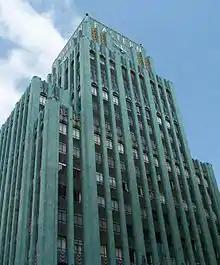 |
849 S. Broadway | Downtown Los Angeles | Thirteen-story Zig-Zag Moderne structure designed by Claude Beelman in 1895; strong verticality due to deeply recessed bands of paired metal-sash casement windows set between fluted vertical piers | ||
| 299 | Embassy Auditorium and Hotel |  |
851 S. Grand Ave. | Downtown Los Angeles | Nine-story Beaux Arts structure with four-story Baroque dome built in 1913, designed by Thornton Fitzhugh; finely detailed 1,500-seat auditorium | ||
| 312 | Japanese Union Church of Los Angeles |  |
120 N. San Pedro St. 34°3′3.56″N 118°14′23.74″W |
Little Tokyo | Neo-Classical church built in 1923, designed by H.M Patterson; the first church built to house a Protestant congregation for the city's Japanese-American population; Now houses the Union Center for the Arts. | ||
| 313 | Los Angeles Hompa Hongwanji Buddhist Temple |  |
October 24, 1986 | 109–119 N. Central Ave.; 355–369 E. 1st St. | Little Tokyo | Buddhist temple built 1924–25 designed by Edgar Cline; one of the first religious structures serving the city's Asian population; later became the Japanese American National Museum. | |
| 317 | Young Apartments |  |
January 7, 1987 | 1621 S. Grand Ave. | Downtown Los Angeles | Classical Revival structure built in 1911, designed by Robert Brown Young; noted for its ornate designs and scrolled brackets | |
| 323 | Church of the Open Door | 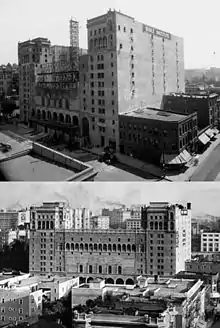 |
550 S. Hope St. | Downtown Los Angeles | Italian Renaissance style church with two 13-story towers built in 1914; demolished in 1988 | ||
| 340 | Standard Oil Company Building |  |
605 W. Olympic Blvd. | Downtown Los Angeles | Beaux Arts structure designed by George W. Kelham, built in 1928 | ||
| 345 | Harris Newmark Building |  |
127 E. 9th St. | Downtown Los Angeles | Twelve-story Renaissance Revial building designed in 1926 by Curlett & Beelman | ||
| 346 | Coast Federal Savings Building |  |
315 W. 9th St. | Downtown Los Angeles | Twelve-story U-shaped structure built in 1926, designed by Morgan, Walls & Clements | ||
| 347 | One Bunker Hill Building |  |
601 W. 5th St. | Bunker Hill | Formerly the Southern California Edison Company Building, a 14-story Art Deco bldg. built 1930–34, designed by Allison & Allison. | ||
| 348 | Fire Station No. 28 |  |
644 S. Figueroa St. | Downtown Los Angeles | Former fire station built in 1922 and later converted into a restaurant serving cuisine based on fire station recipes | ||
| 354 | Giannini-Bank of America |  |
649 S. Olive St. | Downtown Los Angeles | Renaissance Revival structure with monumental Corinthian columns, decorative ironwork and rusticated stone; designed by Morgan, Walls & Clements in 1922 for the Bank of Italy | ||
| 355 | Roosevelt Building | 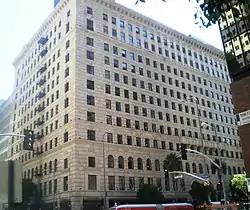 |
727 W. 7th St. | Downtown Los Angeles | Twelve-story Beaux Arts Renaissance Revival built in 1923, designed by Curlett & Beelman; noted for its monumental arches on the 7th Street facase | ||
| 356 | Barker Brothers Building |  |
818 W. 7th St. | Downtown Los Angeles | Beaux Arts Renaissance Revival structure built in 1925 as main store for the city's largest home furnishings company; designed by Curlett & Beelman | ||
| 357 | Boston Store-J.W. Robinson's |  |
600 W. 7th St. | Downtown Los Angeles | Department store built in 1915, completely remodeled in 1934 with design by Allison & Allison | ||
| 358 | Brock Jewelers-Clifton's |  |
513 W. 7th St. | Downtown Los Angeles | Four-story structure built in 1922 for jewelry manufacturer; later housed Clifton's Cafeteria | ||
| 385 | Title Insurance & Trust Company Building and Annex | .jpg.webp) |
419–433 S. Spring St. | Spring Street Financial District | Two buildings designed by The Parkinsons; the main building is known for its restrained Zig-Zag Moderne style and Art Deco lobby | ||
| 398 | Pacific Mutual Building |  |
August 6, 1982 | 523 W. 6th St. | Downtown Los Angeles | Three connected structures was once home to the Pacific Life Insurance Company ; the original 1908 Beaux Arts building was remodeled in 1929 when the large central unit was built | |
| 449 | Palace Theater | .jpg.webp) |
630 S. Broadway | Broadway Theater District | French classical theater built in 1911 as an Orpheum Theater; facade details by Domingo Mora; first use of polychrome terra-cotta in Los Angeles[4] | ||
| 450 | Tower Theatre (Los Angeles) | .jpg.webp) |
800 S. Broadway | Broadway Theater District | Theater built in 1927 and designed by S. Charles Lee; it was downotown's first theater built for talking motion pictures; noted for its terra cotta details on its facade and art-glass window over the entry | ||
| 459 | Hamburger's Department Store | 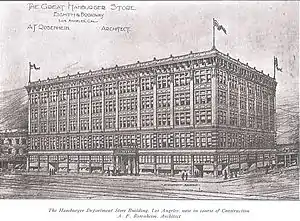 |
801–829 S. Broadway | Broadway Theater District | Six-story, steel-frame Beaux Arts department store designed by Alfred F. Rosenheim, built in 1907 | ||
| 460 | Mayan Theater |  |
1044 S. Hill St. | Downtown Los Angeles | Theater built in 1927 by Morgan, Walls & Clements with Mayan decorations by Francisco Cornejo; later converted into a night club | ||
| 472 | Rialto Theater (Marquee, Box Office & Original Marble Entry Floor) | .JPG.webp) |
812 S. Broadway | Broadway Theater District | Rare example of a 1930s rectangular marquee with original neon elements and Art Deco box office | ||
| 476 | Belasco Theater | _(14597460449)_(cropped).jpg.webp) |
1046–1054 S. Hill St. | Downtown Los Angeles | Six-story steel-reinforced structure built in 1926 for live theater; designed by Morgan, Walls & Clements with cast stone details in Churrigueresque, Moorish and Gothic styles | ||
| 480 | Spanish–American War Memorial |  |
Pershing Square | Downtown Los Angeles | Life-size granite statue of soldier completed in 1900 by S.M. Goddard as a memorial to seven local soldiers who died in the Spanish–American War | ||
| 522 | State Theater Building |  |
701–713 S. Broadway & 300–314 W. 7th St. | Broadway Theater District | Steel reinforced theater build in 1921 in the Plateresque style; built as a Loew's theater | ||
| 523 | United Artists Theater Building |  |
927–939 S. Broadway | Broadway Theater District | First theater built by United Artists; built in 1927 in Spanish Gothic style | ||
| 524 | Cameo Theater (formerly Clune's Broadway) | 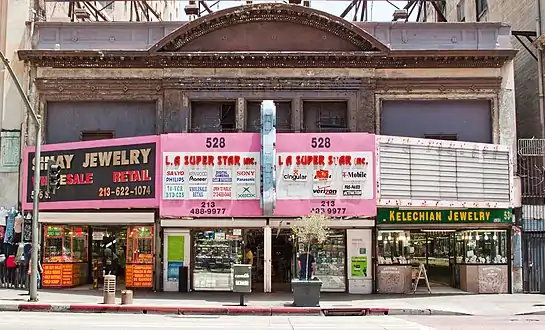 |
526–530 S. Broadway |
Broadway Theater District | Theater designed by Alfreed F. Rosenheim, built in 1910; it was the longest continually operating movie theater in California until it closed in the 1990s | ||
| 525 | Arcade Theater (formerly Pantages Theater) |  |
532–536 S. Broadway |
Broadway Theater District | Theater built by vaudeville producer Alexander Pantages in 1910 with Beaux Arts facade | ||
| 526 | Roxie Theater | .jpg.webp) |
512–524 S. Broadway | Broadway Theater District | Art Deco movie theater built in 1931, designed by John Cooper | ||
| 544 | Irvine-Byrne Building |  |
249 S. Broadway | Downtown Los Angeles | Five-story Beaux Arts building designed by Sumner Hunt, built in 1895 | ||
| 596 | Petroleum Building |  |
April 26, 1994 | 700–714 W. Olympic Blvd./1001-1013 S. Flower St. | Downtown Los Angeles | Meyer & Holler designed the 1925 building with the feeling of Florentine palaces of the early Renaissance period | |
| 615 | San Pedro Firm Building |  |
January 18, 1995 | 108–116 N. San Pedro St. | Little Tokyo | William E. Young designed this 1925 Classical Revival style building; it helps document the history of the Japanese American community; a mixed-use building of apartments over stores; features formal symmetric facade, brick pilasters, and a major elevation organized into three horizontal zones. | |
| 631 | Banks-Huntley Building |  |
634 S. Spring St. | Spring Street Financial District | |||
| 671 | Barclay's Bank |  |
639–641 S. Spring St. | Spring Street Financial District | |||
| 686 | Superior Oil Company Building |  |
550 S. Flower St. | Downtown Los Angeles | |||
| 708 | Gerry Building |  |
910 S. Los Angeles St. 34°2′25.56″N 118°15′15.86″W |
Fashion District | Streamline Modern building in Fashion District originally used for garment manufacture | ||
| 709 | Gray Building |  |
824 S. Los Angeles St. | Fashion District | |||
| 710 | M. J. Connell Buildings 1, 2, 3 & 7 |  |
714, 716, 720 & 724 S. Los Angeles St. | Fashion District | |||
| 711 | M. J. Connell Buildings 4, 5, & 6 |  |
738 & 746 S. Los Angeles St. and 743 Santee St. | Fashion District | |||
| 712 | Textile Center Building | 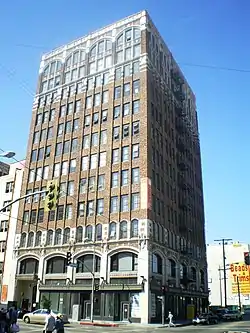 |
315 E. 8th St. | Fashion District | Landmark building in the Fashion District developed in 1926 by pioneering female developer, Florence Casler; now converted into condominiums | ||
| 728 | San Fernando Building |  |
400 S. Main St. | Downtown Los Angeles | Renaissance Revival style office building dating to 1906; part of the Old Bank District loft project | ||
| 729 | Hellman Building | .jpg.webp) |
410 S. Spring St. | Spring Street Financial District | |||
| 730 | Continental Building | %252C_Los_Angeles.JPG.webp) |
408 S. Spring St. | Spring Street Financial District | |||
| 737 | Gans Brothers Building | 814 S. Spring St. | Downtown Los Angeles | ||||
| 741 | Security Building | .jpg.webp) |
500–510 S. Spring St. | Spring Street Financial District | |||
| 748 | South Park Loft Building |  |
816 S. Grand Ave. | Downtown Los Angeles | Highrise parking garage designed by Claud Beelman and built in 1924; now known as "South Park Lofts" | ||
| 765 | Blackstone's Department Store |  |
901 S. Broadway | Downtown Los Angeles | |||
| 766 | General Petroleum Building | 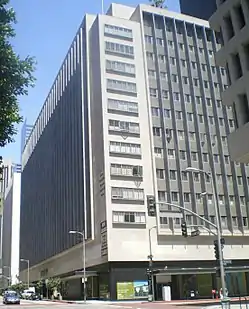 |
612 S. Flower St. | Downtown Los Angeles | Highrise built in 1949 as offices for oil company; later converted into the Pegasus Apartments | ||
| 772 | Title Insurance Building | .jpg.webp) |
456 S. Spring St. | Spring Street Financial District | |||
| 786 | Edwards-Wildey Building |  |
609 S. Grand Ave. | Downtown Los Angeles | |||
| 789 | Southern California Gas Company Complex |  |
800–820 S, Flower St. | Downtown Los Angeles | |||
| 795 | Santa Fe Inbound Freight House | 355 S. Santa Fe | Downtown Los Angeles | ||||
| 806 | Kerckoff Building and Annex |  |
558–564 S. Main St. | Downtown Los Angeles | |||
| 825 | Chinatown West Gate |  |
954 N. Hill St. | Chinatown | West gate into New Chinatown, which was founded in 1938 by Chinese-Americans after they were relocated from their site at Union Station. | ||
| 826 | Chinatown East Gate | .jpg.webp) |
945 N. Broadway | Chinatown | East gate entrance to New Chinatown, a first outdoor mall in the United States that was built in 1938 by Chinese-Americans. | ||
| 871 | 810 South Spring Street Building |  |
2007 | 810 S. Spring St. | Downtown Los Angeles | Twelve-story Beaux-Arts building designed by architects Albert R. Walker and Percy A. Eisen, who also designed the Fine Arts Building and the James Oviatt Building. | |
| 872 | Raphael Junction Block Building (New York Suspender Factory-California Ice Company) | 2007 | 1635–1637 N. Spring St. | Chinatown | The Victorian-era Flatiron style building was built in 1889 for Charles Raphael, a Los Angeles businessman. Triangular in shape, it housed the New York Suspender Factory and the California Ice Company. | ||
| 873 | Higgins Building |  |
2007 | 108 W. 2nd St. | Downtown Los Angeles | This 10-story Beaux-Arts style building was built and owned by Thomas Higgins in 1909; Albert C. Martin, Sr. and A.L. Haley were architects; housed the Los Angeles County Engineer Department for many years. Clarence Darrow was a tenant. | |
| 881 | Judson Rives Building |  |
424 S. Broadway | Downtown Los Angeles | |||
| 888 | National Biscuit Company Building |  |
1850 Industrial St. | Downtown Los Angeles | |||
| 898 | Van Nuys Building |  |
204–212 W. 7th St., 701 S. Spring St. | Spring Street Financial District | |||
| 899 | Charles C. Chapman Building | %252C_ca.1913-1918_(CHS-2321).jpg.webp) |
756 S. Broadway | Downtown Los Angeles | |||
| 900 | North Spring Street Bridge, No. 53C0859 |  |
N. Spring St. between Aurora St. and S. Avenue 18 34°4′14.55″N 118°13′28.8″W |
Downtown Los Angeles | |||
| 901 | North Main Street Bridge, No. 53C1010 |  |
N. Spring St. between Chavez St. and Albion St. | Downtown Los Angeles | |||
| 902 | Olympic Boulevard Bridge, No. 53C0163 | E. Olympic Blvd. between Rio Vista Ave. and Santa Fe Ave. | Downtown Los Angeles | ||||
| 904 | Seventh Street Bridge, No. 53C1321 | E. 7th St. between Santa Fe Ave. and Meyers St. | Downtown Los Angeles | ||||
| 906 | Fourth Street Bridge, No. 53C0044 |  |
E. 4th St. between Santa Fe Ave. and Mission Rd. | Downtown Los Angeles | |||
| 909 | First Street Bridge, No. 53C1166 |  |
E. 1st St. between Vignes St. and Mission Rd. | Downtown Los Angeles | |||
| 920 | Aoyama Tree | May 20, 2008 | 135 N. Central Ave. | Little Tokyo | Ficus macrophylla (Moreton Bay Fig). The 1920 planted rubber tree is the symbolic of the history of the Koyasan Buddhist Temple and the Japanese Americans in Los Angeles. | ||
| 930 | Garment Capitol Building |  |
July 29, 2008 | 217–221 E. 8th St. | Downtown Los Angeles | ||
| 937 | Westinghouse Electric Building |  |
October 28, 2008 | 420 S. San Pedro St. 34°2′41.47″N 118°14′33.51″W |
Downtown Los Angeles | Art Deco, 1922.[5] | |
| 953 | Foreman & Clark Building |  |
May 20, 2009 | 701 S. Hill St. 34°2′45″N 118°15′17.66″W |
Downtown Los Angeles | Art Deco-Gothic style, 1929, flagship of Foreman & Clark department stores.[6] | |
| 957 | Great Republic Life Building |  |
May 20, 2009 | 756 S. Spring St. 34°2′37.54″N 118°15′10.74″W |
Downtown Los Angeles | Built 1923.[6] | |
| 966 | Douglas Building |  |
September 23, 2009 | 257 S. Spring St. 34°3′2.44″N 118°14′48.46″W |
Downtown Los Angeles | Classical Revival, 1898, designed by Reid Brothers.[7] | |
| 984 | Spreckels Building |  |
June 8, 2010 | 708–716 S. Hill St. | Downtown Los Angeles | This 1922 Beaux-Arts style building was constructed for the real estate firm of Dunn & Williams of San Francisco; sold in 1924 to real estate entrepreneurs John and Adolph Spreckels. It has associated with the commercial and financial development of Downtown.[8] | |
| 985 | Sun Realty Company Building |  |
June 8, 2010 | 629–633 S. Hill St. | Downtown Los Angeles | Art Deco style, 1930.[8] | |
| 1001 | May Company Garage |  |
June 1, 2011 | 9th and Hill Streets | Downtown Los Angeles | Beaux-Arts style nine-story parking garage and retail building built in 1927. Designed by Claude Beelman and William Curlett, | |
| 1019 | Metropolitan Building |  |
April 27, 2011 | 315 W. 5th Street | Downtown | Constructed in 1913 | |
| 1022 | Los Angeles Department of Water and Power General Office Building (John Ferraro Building) |  |
September 21, 2011 | 111 N. Hope Street | Civic Center | ||
| 1074 | Times-Mirror Square (Los Angeles Times Building) |  |
December 5, 2018 | First and Spring Streets | Civic Center | 1935-1973, City Council action removed the 1973 William Pereira addition from the nomination | |
| 1140 | Hotel Cecil |  |
January 28, 2017 | 640 S. Main Street | Downtown Los Angeles | Beaux-Arts-style hotel built in 1924 |
Listed in the National Register of Historic Places
| Code[9] | Landmark name | Image | Selected date | Locality | Neighborhood | Description[2] |
|---|---|---|---|---|---|---|
| Bradbury Building | File:Bradbury building Los Angeles c2005 01383u.jpg | 304 S. Broadway | Broadway Theatre District | Architectural masterpiece built in 1893. Known for its vast sunlit atrium used as an iconic filming location for over 100 years. | ||
| Broadway Theater and Commercial District | 300-849 S. Broadway | Broadway Theater District | First and largest historic theater district on the National Register; with 12 movie palaces in 6 blocks, the largest concentration of movie palaces in the United States | |||
| Spring Street Financial District |  |
354-704 S. Spring St. | Spring Street Financial District | Once known as the "Wall Street of the West", the old financial district includes the city's first skyscraper and more than 20 other historic buildings along a three-block stretch of Spring | ||
| Little Tokyo Historic District | 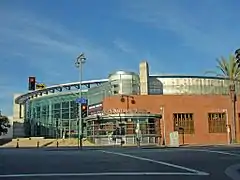 |
1995 | 301-369 First and 106-120 San Pedro Sts. | Little Tokyo | Cultural center for Japanese Americans in Southern California, former site of the first Nishi Honganji Buddhist Temple | |
| Board of Trade Building |  |
111 W. 7th St. | Downtown Los Angeles | Beaux-Arts highrise designed by Claud Beelman used as headquarters for California Stock Exchange starting in 1930 | ||
| Federal Reserve Bank of San Francisco, Los Angeles Branch | 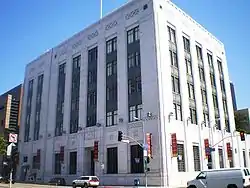 |
409 W. Olympic Blvd. | Downtown Los Angeles | Original Los Angeles branch building of the Federal Reserve Bank of San Francisco built in 1929; designed by The Parkinsons in a Moderne style | ||
| Million Dollar Theater |  |
307 S. Broadway | Broadway Theater District | One of the first movie palaces built in the United States | ||
| Santa Fe Freight Depot |  |
970 E. 3rd St. | Downtown Los Angeles | Former freight depot built in 1922, converted in 2000 into campus for architectural school; the quarter-mile long building stretches further than the height of the Empire State Building | ||
| United States Court House (Spring Street, Los Angeles) |  |
312 N. Spring St. | Downtown Los Angeles | |||
| United States Post Office - Los Angeles Terminal Annex |  |
900 Alameda St. | Downtown Los Angeles | Mission Revival building designed by Gilbert Stanley Underwood; LA's central mail processing facility from 1940 to 1989 | ||
| Plaza Substation |  |
10 Olvera St. | Old Plaza District | Electrical substation that was part of the "Yellow Car" streetcar system operated by the Los Angeles Railway from 1904 to 1963 | ||
See also
Lists of L.A. Historic-Cultural Monuments
- Historic-Cultural Monuments on the East and Northeast Sides
- Historic-Cultural Monuments in the Harbor area
- Historic-Cultural Monuments in Hollywood
- Historic-Cultural Monuments in the San Fernando Valley
- Historic-Cultural Monuments in Silver Lake, Angelino Heights, and Echo Park
- Historic-Cultural Monuments in South Los Angeles
- Historic-Cultural Monuments on the Westside
- Historic-Cultural Monuments in the Wilshire and Westlake areas
Notes
- Numbers are as designated by the L.A. Historic-Cultural Monuments program.
- Blue colors represent national notability as National Historic Landmarks and are separately listed on the National Register of Historic Places.
- Yellow represents sites that are L.A. Historic-Cultural Monuments without a higher designation.
- No color represents delisted monuments.
References
- Department of City Planning. "Designated Historic-Cultural Monuments". City of Los Angeles. Archived from the original on 2010-06-09. Retrieved 2010-06-15.
- Various sources cited in articles, retrieved on various dates.
- "Archived copy". Archived from the original on 2011-05-24. Retrieved 2011-04-16.CS1 maint: archived copy as title (link)
- Sandra A.B. Levis. "Broadway Historic Theater District: A walking tour sponsored by the Los Angeles Conservancy" (PDF). Los Angeles Conservancy.
- Office of Historic Resources, Newsletter, January 2009.
- Office of Historic Resources, Newsletter, July 2009.
- Office of Historic Resources, Newsletter, October 2009.
- Office of Historic Resources, Newsletter, July 2010.
- Numbers in 1000 series denote LAHCM assigned numbers for state-designated sites; 2000 series denote LAHCM assigned numbers for federally designated sites. Blue colors represent higher designations as National Historic Landmarks and/or listing on the National Register of Historic Places. No color represents information is unavailable or the monument has been delisted. To resort on this column, refresh your browser.
External links
| Wikimedia Commons has media related to Los Angeles Historic-Cultural Monuments (citywide). |
- Los Angeles Office of Historic Resources: Designated L.A. Historic-Cultural Monuments (LAHCM) website — with 'ever-updated' LAHCM List via PDF link.
- Historic-Cultural Monument (HCM) Report for Central City
- Historic-Cultural Monument (HCM) Report for Central City North
- Big Orange Landmarks: "Exploring the Landmarks of Los Angeles, One Monument at a Time" — Central City L.A.H.C. Monuments. — online photos and in-depth history. — website curator: Floyd B. Bariscale.
- Big Orange Landmarks: "Exploring the Landmarks of Los Angeles, One Monument at a Time" — Central City North L.A.H.C. Monuments.
This article is issued from Wikipedia. The text is licensed under Creative Commons - Attribution - Sharealike. Additional terms may apply for the media files.